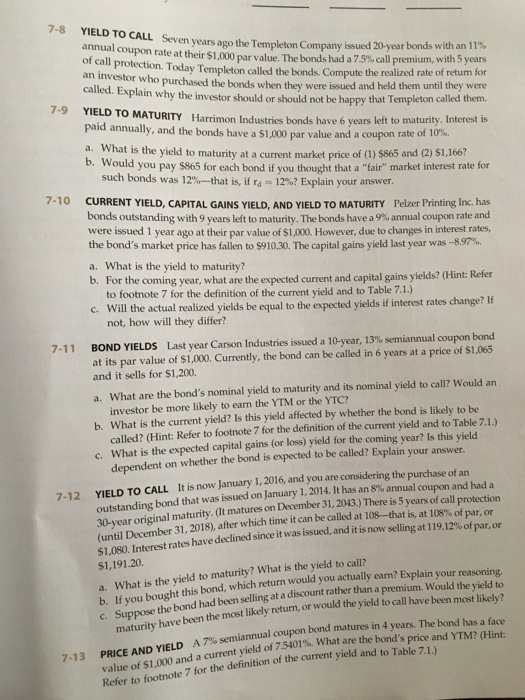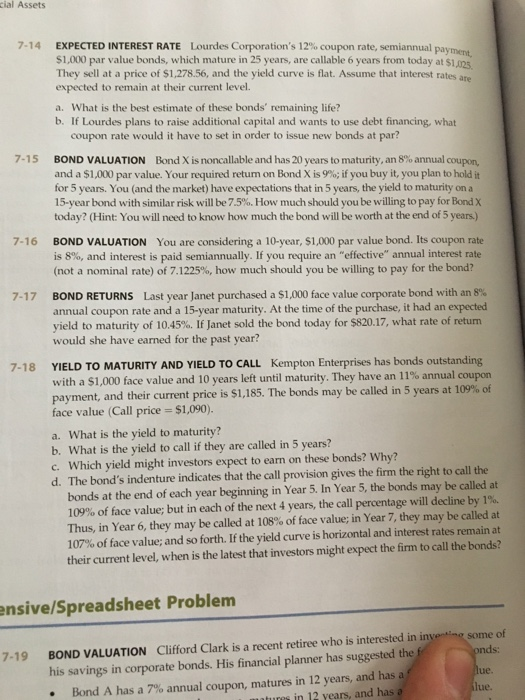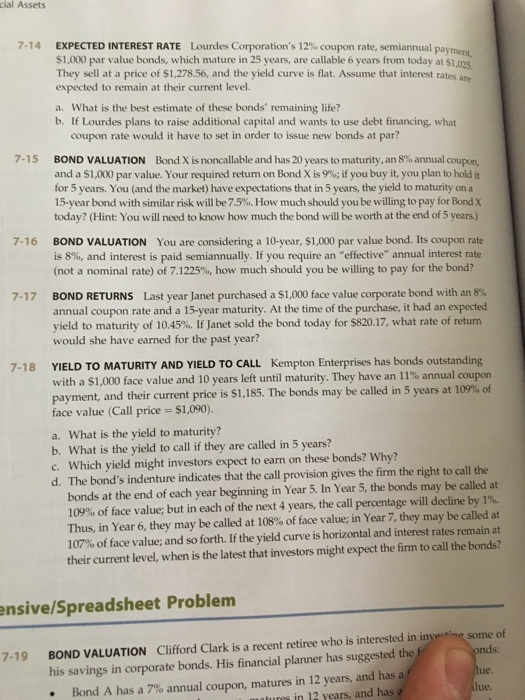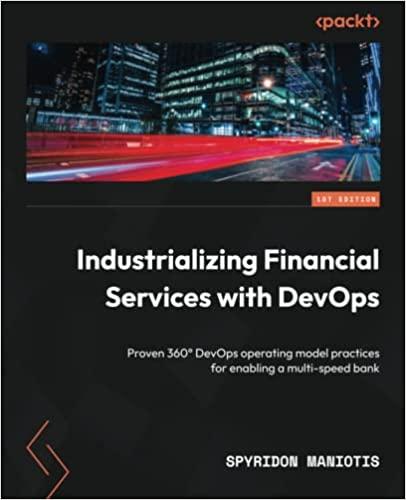
7-8,7-10

7-15

7-15
7-8 YIELD TO CALL Seven years ago the Templeton Company annual coupon rate at their $1,000 par value. The bonds had a 75% call pretnium, with 5 years of call protection. Today Templeton called the bonds. Compute the realized ra issued 20-year bonds with an ii% n investor who purchased the bonds when they were issued and held them until they were called. Ex plain why the investor should or should not be happy that Templeton called them. 7-9 YIELD TO MATURITY Harrimon Industries bonds have 6 years left to maturity paid annually, and the bonds have a $1,000 par value and a coupon rate of 10% a. What is the yield to maturity at a current market price of (1) 5865 and (2) $1,166? b. W ould you pay $865 for each bond if you thought that a "fair" market interest rate for such bonds was 12%-that is, if ra-12%? Explain your answer CURRENT YIELD, CAPITAL GAINS YIELD, AND YIELD TO MATURITY bonds outstanding with 9 years left to maturity. The bonds have a 9% annual coupon rate and were issued 1 year ago at their par value of $1,000. However, due to changes in interest rates, the bond's market price has fallen to S91030. The capital gains yield last year was-8.97% a. What is the yield to maturity? 7-10 Pelzer Printing Inc. has ng year, what are the expected current and capital gains yields? (Hint: Refer to footnote 7 for the definition of the current yield and to Table 7.1.) c. Will the actual realized yields be equal to the expected yields if interest rates change? If not, how will they differ? 7-11 Last year Carson Industries issued a 10-year, 13% semiannual coupon bond BOND YIELDS at its par value of $1,000. Currently, the bond can be called in 6 years at a price of and it sells for $1,200. a. What are the bond's nominal yield to maturity and its nominal yield to call? Would arn investor be more likely to earn the YTM or the YTC? b. What is the current yield? Is this yield affected by whether the bond is likely to be called? (Hint: Refer to footnote 7 for the definition of the current yield and to Table 7.1.) What is the expected capital gains (or loss) yield for the coming year? Is this yield c. dependent on whether the bond is expected to be called? Explain your answer It is now January 1, 2016, and you are considering the purchase of an YIELD TO CALL outstanding bond that was issued on January 1, 2014 It has an 8% annual coupon and had a 30-year original maturity. (It matures on December 31, 2043.) There is 5 years of (until Doember $1,080. Interest rates have declined since it was issued, and it is now selling at 119.12 $1,191.20. 7-12 call protection 31, 2018), after which time it can be called at 108-that is, at 108% of par, or a. What is the yield to maturity? What is the yield to call? b. If you bought this bond, which return would you actually earn? Explain your reasoni Suppose the bond maturity have been the most likely return, or would the yield to call have been had been selling at a discount rather than a premium. Would the yield to most likely? C. iannual coupon bond matures in 4 years. The bond has a face yield of 7.5401%. What are the bond's price and YTM? (Hint A 7% sem PRICE AND YIELD value of $1,000 and a current Refer to footnote 7-13 , te 7 for the definition of the current yield and to Table 7.1.) cial Assets EXPECTED INTEREST RATE Lourdes Corporation's 12% coupon rate, semiannual pa $1,000 par value bonds, which mature in 25 years, are callable 6 years from today at $1 They sell at a price of $1,278.56, and the yield curve is flat. Assume that interest ra expected to remain at their current level payment a. What is the best estimate of these bonds' remaining life? b. If Lourdes plans to raise additional capital and wants to use debt financing, what coupon rate would it have to set in order to issue new bonds at par? BOND VALUATION Bond X is noncallable and has 20 years to maturity, an 8% annual coupon, and a $1,000 par value. Your required return on Bond X is 9%; if you buy it, you plan to hold it for 5 years. You (and the market) have expectations that in 5 years, the yield to maturity on a 15-year bond with similar risk will be 7.5%. How much should you be willing to pay for Bon X today? (Hint: You will need to know how much the bond will be worth at the end of 5 years.) 7-16 You are considering a 10-year, $1,000 par value bond. Its coupon BOND VALUATION is 8%, and interest is paid semiannually. If you require an "effective" annual interest rate (not a nominal rate) of 7.1225%, how much should you be willing to pay for the bond? Last year Janet purchased a $1,000 face value corporate bond with an 8% BOND RETURNS annual coupon rate and a 15-year maturity. At the time of the purchase, it had an expected yield to maturity of 10.45%. If Janet sold the bond today for $820.17, what rate of retum would she have earned for the past year? 17 Kempton Enterprises has bonds outstanding YIELD TO MATURITY AND YIELD TO CALL with a $1,000 face value and 10 years left until maturity. They have an 11% annual coupon payment, and their current price is $1,185. The bonds face value (Call price $1,090). 7-18 a. What is the yield to maturity? b. What is the yield to call if they are called in 5 years? c. Which yield might investors expect to earn on these bonds? Why? d. The bond's indenture indicates that the call provision gives the firm the right to call the bonds at the end of each year beginning in Year 5. In Year 5, the bonds may be called at 109% of face value, but in each of the next 4 years, the call percentage will decline by 1 Thus, in Year 6, they may be called at 108% of face value in Year 7, they may be called at 107% of face value; and so forth. If the yield curve is horizontal and interest rates remain at their current level, when is the latest that investors might expect the firm to call the bonds? nsive/Spreadsheet Problemm BOND VALUATION Clifford Clark is a recent retiree who is interested in in his savings in corporate bonds. His financial planner has suggested th . Bond A has a 7% annual coupon, matures in 12 years, and has some of ue lue. atures in 12 years, and has cial Assets EXPECTED INTEREST RATE Lourdes Corporation's 12% coupon rate, semiannual pa $1,000 par value bonds, which mature in 25 years, are callable 6 years from today at $1 They sell at a price of $1,278.56, and the yield curve is flat. Assume that interest ra expected to remain at their current level payment, a. What is the best estimate of these bonds' remaining life? b. If Lourdes plans to raise additional capital and wants to use debt financing, what coupon rate would it have to set in order to issue new bonds at par? BOND VALUATION Bond X is noncallable and has 20 years to maturity, an 8% annual coupon, and a $1,000 par value. Your required return on Bond X is 9%; if you buy it, you plan to hold it for 5 years. You (and the market) have expectations that in 5 years, the yield to maturity on a 15-year bond with similar risk will be 75%. How much should you be willing to pay for Bon X today? (Hint: You will need to know how much the bond will be worth at the end of 5 years.) 7-16 You are considering a 10-year, $1,000 par value bond. Its coupon BOND VALUATION is 8%, and interest is paid semiannually. If you require an "effective" annual interest rate (not a nominal rate) of 7.1225%, how much should you be willing to pay for the bond? BOND RETURNS annual coupon rate and a 15-year maturity. At the time of the purchase, it had an expected yield to maturity of 10.45%. If Janet sold the bond today for $820.17, what rate of return would she have earned for the past year? 7-17 Last year Janet purchased a S1 ,000 face value corporate bond with an 8% Kempton Enterprises has bonds outstanding YIELD TO MATURITY AND YIELD TO CALL with a $1,000 face value and 10 years left until maturity. They have an 11% annual coupon payment, and their current price is $1,185. The bonds face value (Call price $1,090). 7-18 a. What is the yield to maturity? b. What is the yield to call if they are called in 5 years? c. Which yield might investors expect to earn on these bonds? Why? d. The bond's indenture indicates that the call provision gives the firm the right to call the bonds at the end of each year beginning in Year 5. In Year 5, the bonds may be called at 100% of face value, but in each of the next 4 years, the call percentage will decline by 1 Thus, in Year 6, they may be called at 108% of face value, in Year 7, they may be called at 107% of face value; and so forth. If the yield curve is horizontal and interest rates remain at their current level, when is the latest that investors might expect the firm to call the bonds? nsive/Spreadsheet Problemm BOND VALUATION Clifford Clark is a recent retiree who is interested in inv his savings in corporate bonds. His financial planner has suggested the . Bond A has a 7% annual coupon, matures in 12 years, and has some of ue lue. atures in 12 years, and has
 7-8,7-10
7-8,7-10 7-15
7-15 7-15
7-15





